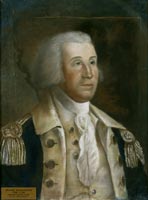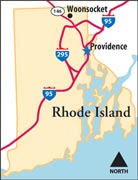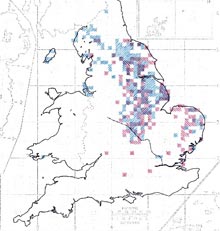THE FIRST AMERICAN THEATRE
The history of the theatre in America begins early in the Eighteenth Century, about the time the first rumblings were heard of the storm which was to break the ties still holding the Colonies to the mother country.

William Dunlap, the earliest historian of the American stage, tells us that the drama was first introduced in this country by the Hallams in the year 1752 when they brought over a company from London and presented The Merchant of Venice at Williamsburg, then the capital of Virginia, in a building arranged for that purpose. "This," says Dunlap "was the first theatre opened in America by a company of regular comedians." This singularly misleading statement is perhaps the most conspicuous of a number of similar erroneous assertions which mar an otherwise valuable and interesting work. [1] Dunlap ignored or was uninformed of a number of well authenticated dramatic performances which had been given in different parts of the Colonies many years before the arrival of the Hallams. Apparently, he knew nothing of the theatre built in Williamsburg, VA., in 1716. He had no knowledge of the theatre opened in New York in 1732. He makes no mention of the opening of the Playhouse in Dock Street, Charleston, S.C., in 1736. [2] He had never heard of Thomas Kean who acted Richard III at the First Nassau Street Theatre, New York, March 5, 1750.
Even so careful an historian as Joseph N. Ireland falls into the error of taking it for granted that no earlier records existed because he had not happened to stumble upon them. In his Records of the New York Stage, [3] referring to an advertisement in Bradford"s Gazette of October, 1733, which mentions George Talbot"s store as being "next door to the Playhouse," he says, "No other reference has been found respecting it (the Playhouse) and any conjecture as to its proprietors, its performers, or the plays presented therein would be vain and fruitless."
How little "vain and fruitless" may be judged from that fact that today we not only know what play was performed in this New York theatre of 1732, but also who some of the players were.
Virginia has some claim to be considered the cradle of the Native American theatre, but 1752 was not the date of the drama"s birth in this country. There were theatrical performances in Williamsburg and acting in New York by professional players many years earlier than that. We know that a regular theatre was built in Williamsburg and performances given as early as 1716. We also know that Murray and Kean"s troupe of professional players acted Richard III iin Williamsburg some time before the Hallams arrived and presented The Merchant of Venice. In fact, the Hallams used the same theatre that the Murray-Kean company had recently occupied.
In view of the more than scant information regarding plays and players in the pre-Revolutionary newspapers and chronicles of the time, it would be an impossible task to attempt to ascertain when or where the first theatrical performance took place on the North American continent. It is likely that there were scattered dramatic performances of a sort in all the Colonies many years before we have any records of them, particularly in the South where the prejudice against the stage was less violent than in the North, but singularly enough it is in the Puritanical New England provinces that we find the first actual records of public theatricals, and in Quaker Philadelphia that the drama first found a permanent home.
That so little should be known of the early beginnings of the acted drama in America is not surprising when one considers the intolerance of the age against the theatre and the player. In face of the almost general condemnation of the playhouse the journals of the day were not encouraged to give much, if any, space in their slender columns to the doings of player-folk. It was also the custom at that time for the actors themselves to distribute handbills at the houses of prospective theatre goers, and thus stir up interest in the coming performance, instead of depending solely on newspaper advertising as is the modern practice. These reasons, perhaps, sufficiently explain the almost total absence of theatrical news in the pre-Revolutionary newspapers, a fact which has rendered exceedingly difficult the researches of the historian.

In the South the Colonists had imported a taste for the drama together with their other English customs, but in the North the playhouse was still considered the highway to hell and was everywhere fiercely condemned if not actually forbidden under the severest penalties. In 1750 the General Court of Massachusetts passed an act prohibiting stage plays and theatrical entertainments of any kind. On May 31, 1759, the House of Representatives in the Colony of Pennsylvania passed a law forbidding the showing and acting of plays under a penalty of £500. In 1761 Rhode Island passen "an act to Prevent Stage Plays and other Theatrical Entertainments within this Colony," and the following year the New Hampshire House of Representatives refused a troupe of actors admission to Portsmouth on the ground that plays had a "peculiar influence on the minds of young people and greatly endanger their morals by giving them a taste for intriguing, amusement and pleasure." In 1824 President Dwight of Yale College in his "Essay on the Stage" declared that "to indulge a taste for playgoing means nothing more or less than the loss of that most valuable treasure the immortal soul." Even as late as 1856, when the city of Brooklyn could boast of only one theatre and the citizens were gravely contemplating the erection of another, there was considerable opposition to the word "theatre," a compromise being finally reached by calling it an Academy of Music. Judge Daly [4] tells an amusing anecdote connected with the preliminary planning of this new house. There was a warm argument among the building committee over the questions of stage and scenery, a determined stand being taken against a curtain. "A curtain," exclaimed one solemn-faced objector, "is intended to conceal something and concealment suggests impropriety." So little versed in the lore of the theatre was this worthy city father that it was necessary to explain to him that stage plays were usually divided into sections, commonly called "acts," and that the curtain was lowered simply to mark the intervals.
Yet in spite of this hostile and uncompromising attitude toward the theatre, stage performances were occasionally, if not frequently, given, usually by special permission of the local authorities. The probability is that the laws forbidding play-acting remained a dead letter in many of the large towns at least, the regulations governing the players being introduced more to placate public opinion at the moment than with any serious intention of suppressing the player altogether as a public nuisance. How else can we account for the theatrical performances in New York in 1702 and again in 1732 or for the performances given in 1714 in Boston and Philadelphia?

It must not be forgotten that while the great majority of the Northern Colonists were bitterly opposed to the playhouse on religious and moral grounds, there was a large and growing class in the important centers who were burdened with no such scruples--people of means and leisure who had only recently crossed the Atlantic and who, when seeking recreation, naturally turned to a form of amusement highly popular at home. It is not unreasonable, then, to presume that as the Colonies grew in importance, and communication between America and Europe became more frequent, the old spirit of irreconcilable intolerance which put a ban on all secular amusements was considerably modified, especially in the important towns. The citizens of these communities, in their moments of leisure, no doubt often longed for the pleasures of the theatre, glowing accounts of which arrived from London by every ship.
The drama in England had gradually risen from the depths into which it had sunk after the Restoration. Under the leadership of Addison, Pope, Steele and Swift began the so-called "Augustan age" of English literature. Dryden, hailed as a new Shakespeare, had already given the stage the vigor and brilliancy of his genius, while Thomas Otway"s tragedy Venus Preserved had earned for him the title of "Euripides of the English Stage." Addison, producing his Cato, the finest English example of classical tragedy, at a moment of great political excitement, met with extraordinary success, calling forth praise even from the cynical Voltaire. Wycherley had made all London laugh with his masterpieces The Country Wife and The Plain Dealer; Congreve, the greatest English master of pure comedy, had produced his crowning triumph Love for Love. Colley Cibber had written his best play, The Careless Husband, and adapted Shakespeare. George Farquhar, leader among the comic dramatists, amused thousands with his sprightly farces The Recruiting Sergeant and The Beaux Stratagem. Sir Richard Steele, catering to the new public taste for sentimental comedy, had won immediate success with The Conscious Lovers. The most famous men in England wrote plays and attended their performance. The pit of the theatre was the resort of wit and learning; while fashion, beauty, taste and refinement, the proud and exclusive aristocracy of the land, took their places in the boxes, surrounding the assemblage of poets and critics below.

The acting of the day was the finest. Thomas Betterton, the great Shakespearean actor, and all the famous players of the Restoration were long past their maturity, but a new generation--Wilks, Cibber, Mrs. Porter, Peg Woffington and others, equally as celebrated--was rising to take their places. Barton Booth, the tragedian of the day, was so popular that he had been admitted to the Patent, while Ann Oldfield, the barmaid who became the associate of duchesses, was the reigning attraction at Drury Lane. Macklin, departing from tradition, had thrilled London by playing Shylock for the first time as a tragic character. In the same year David Garrick, the foremost actor of his age, made his début in Goodman"s Fields as Richard III.
While the American Colonies were growing in wealth and energy, the times were not without their anxieties. There was increasing unrest at the burdens and vexations put on the provinces by the English Parliament and threats of the Colonists to throw off the yoke of the mother country were heard on every hand. The encroachments of the French on the Ohio also created concern, and two years after the Hallams landed in America and made their first bow to Williamsburg audiences Governor Dinwiddie of Virginia dispatched a young officer to the nearest posts to find out what the French were doing. The name of the young officer was George Washington. The French proving obstinate in their claims, the squabble was followed by the Fourth Intercolonial war, which was ended by the taking of Quebec and the conquest of Canada by the British.
The population of the Colonies, at the beginning of the Eighteenth Century, was about six-hundred and fifty thousand. Newport, the metropolis of Rhode Island, had a population of five thousand, including Indians and negroes. Virginia had a population of sixty thousand, of whom about one-half were slaves. Massachusetts mustered about seventy or eighty thousand.
Means of travel in those days were so few and difficult that the cities were practically isolated. Coaches were slow and uncertain. It took a day to go from Philadelphia to New York and three days to go from New York to Boston. The great West was still an unexplored wilderness inhabited by marauding savages. The most popular mode of travel was by water. Hallam and his players selected the ocean route when they went North from Virginia in 1753. As an instance of the difficulties of communication between American cities, even as late as the year 1823, manager W.B. Wood [5] relates how the celebrated star Thomas Abthorpe Cooper one wintry night was unable to fill an important theatre engagement in Philadelphia because he found it impossible to reach that city from New York owing to an ice jam in the Hudson!
New York in 1700 had thirty thousand inhabitants, including seven thousand slaves. By 1732 the population had more than doubled, and it was rapidly becoming a gay and cosmopolitan town. Although not so important as Philadelphia, it grew larger and more prosperous year by year. Commerce thrived, stately ships left its docks for all ports of the world, and beautiful homes rose on each side of "Hudson"s River." The people were industrious and sociable. There still remained among them some influence of the old Dutch burghers" manners and habits, but the predominating tastes were English and French. There were weekly evening clubs and in the winter balls and concerts under the patronage of the new governor. It is only reasonable to presume that among these diversions theatre-going formed a part. The governor, almost invariably a member of the English aristocracy, was usually a man of culture whose taste for literature and art would naturally incline him to encourage rather than frown upon any attempt made to present plays in his jurisdiction, no matter what the local ordinances said to the contrary.
To be continued …